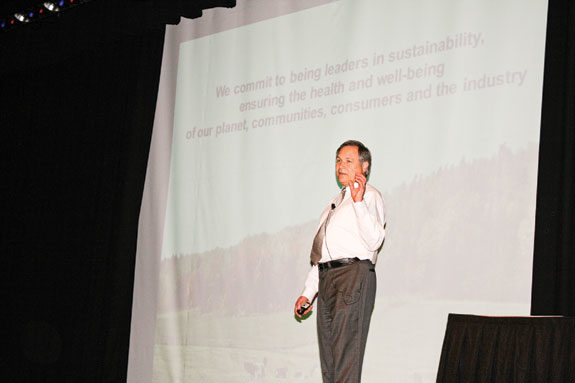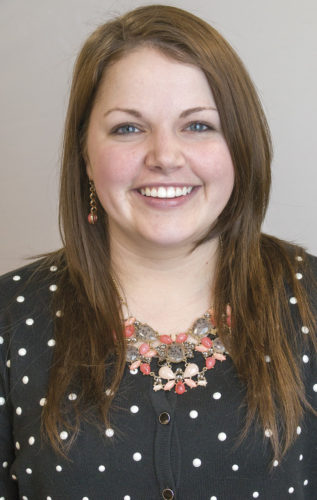From robotic milking to renewable energy and genomics to grazing, producers attending the 2012 Pennsylvania Dairy Summit were offered a variety of topics to stretch their minds. The event was held Feb. 8-9 in Lancaster, Pennsylvania. Those not able to attend the entire two-day conference in person could participate in the “Core Dairy Track for Dairy Managers,” new to the summit this year.
The program, highlighting the most relevant dairy industry topics, was offered from 9 a.m. to 3:40 p.m. and was designed to fit between the morning and afternoon milkings.
Event organizers credited this new offering with an increase in attendance, for a total of about 560 people.
Attendees for the entire event were able to take advantage of “early bird” sessions, offered both days, as well as a “Late Night Show” panel discussion on ethanol production.
The summit kicked off with a presentation from University of Wisconsin’s Bruce Jones, who discussed success factors for the dairy industry over the next 10 years. He urged producers to set financial and management objectives that were both meaningful and achievable.
“If you’re going to be successful, you have to be willing to be measured,” he said.
Next on the schedule was John Niezen of the Greenstone Grazing Group in Louisville, Georgia. Niezen described the challenges and lessons learned when he was hired by three investors based in New Zealand to adapt their intensive grazing management system to the Southeast. He talked about how more producers were looking at ways to incorporate grazing into their operations.
“The dairy industry here has to start looking not only at milk production per cow, but also milk production per acre,” he said.
Attendees had the option to choose two out of a variety of breakout sessions. Topics included succession planning, genomics, alternative feeds, reproduction strategies, welfare-friendly housing and robotic milking.
Click here to see the article, “Northeast producers discuss robotic milking,” featured in the Feb. 13 Progressive Dairyman Extra e-newsletter.
Mark Piper of Fonterra USA offered producers a global perspective of the dairy industry, having worked in New Zealand, Japan and now the U.S.
“As a U.S. dairyman, you’re luckier than most,” Piper said. “You’re able to profit margin and hedge. There’s not a lot of others in the world who can do that.”
Piper encouraged attendees to look for ways to differentiate dairy products and to strive for perfection in quality.
“If you aim for the top all of the time, you have a better chance of reaching it,” he said.
Wednesday’s program ended with a panel discussion about ethanol with Richard Cole, director of the Perdue Agriculture Commodities Marketing Association, and Penn State Extension’s Leon Ressler.
Day two of the conference was just as jam-packed and began with a presentation about transitioning to another generation. Cliff Hanehan of Hanehan Dairy Farms in Stillwater, New York, manages two 700-cow facilities with his two brothers. He shared his experiences of bringing nephews into the management and talked about the effects of two devastating floods.
Cargill Regional Beef’s Drew Wilkins, who manages cattle procurement at the Wyalusing, Pennsylvania, facility, provided producers with a perspective of the cattle industry. He demonstrated the importance Cargill places on food safety and quality, and he urged producers to take that into consideration when culling cows.
“When sending a cow into commerce, ask yourself, ‘Is this something I would feed my family?’,” he said.
A renewable energy panel discussion followed Wilkins’ talk, with presentations from Jerry Bingold of the Innovation Center for U.S. Dairy , Jim Harbach of Schrack Dairy and George Hurst of Oregon Dairy.
Harbach and Hurst discussed their decisions to invest in digesters, struggles they went through and the results they’ve had. Bingold advised producers to begin looking into renewable energy to help the organization’s goal of reducing greenhouse gas emissions of fluid milk by 25 percent by 2020.
Bingold presented producers with an example by showcasing the collaboration between AgSTAR and Big Sky West Dairy in Gooding, Idaho.
The 2012 Dairy Summit concluded with a motivational talk from Dick Beardsley, a marathon runner who survived a near-fatal farm accident. He shared with the group his addiction to pain killers, and his message encouraged producers to appreciate the lessons learned through hardships. PD
Next year’s summit will be held Feb. 6-7, 2013, in Lancaster, Pennsylvania. Visit www.padairysummit.org for more information.

Producers awarded at Dairy Summit
Several awards were presented during the 2012 Dairy Summit.
The Pennsylvania Dairymen’s Association presented three leadership awards, honoring Logan Bower (right) of Blain, Pennsylvania, as the 2012 Charles E. Cowan Memorial Award recipient; Sheryl Vanco (center) of Bear Lake, Pennsylvania, as the 2012 Distinguished Dairy Woman recipient; and Robert C. Goodling Jr., (left) an extension association at Penn State University , with the 2012 Extension Award.
The Pennsylvania Dairy Stakeholders and the Center for Dairy Excellence presented the Pacesetter Award to Ken Raney, executive director of the Pennsylvania Holstein Association , and to Steve and Gina Reinford of Reinford Farms Inc., in Mifflintown, Pennsylvania.
Dale and Carol Hoffman of Kar-Dale Acres in Shinglehouse, Pennsylvania, were also recognized for their involvement and leadership on the board of directors of the Professional Dairy Managers of Pennsylvania .
PHOTOS:
TOP RIGHT: Jerry Bingold of the Innovation Center for U.S. Dairy spoke about the organization’s goal to have 1,300 anaerobic digesters in operation by 2020. Photo by PD Editor Emily Caldwell.
BOTTOM RIGHT: Pennsylvania Dairymen's Association leadership awards presented to Logan Bower (right), Sheryl Vanco (center) and Robert C. Gooding Jr. (left). Photo provided by the Center for Dairy Exellence.

Emily Caldwell
Web Editor
emily@progressivedairy.com



